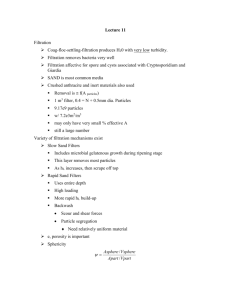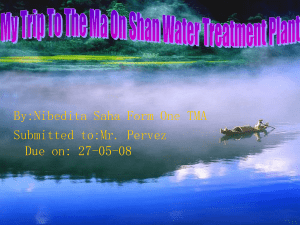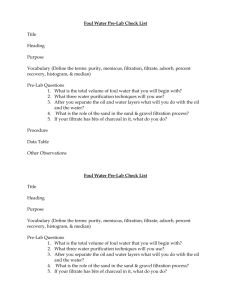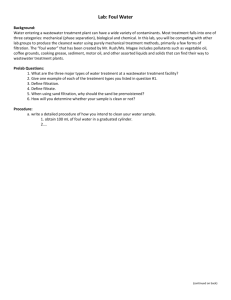POLLUTION SECTION 5-DON’T MUDDY THE WATER OBJECTIVES
advertisement
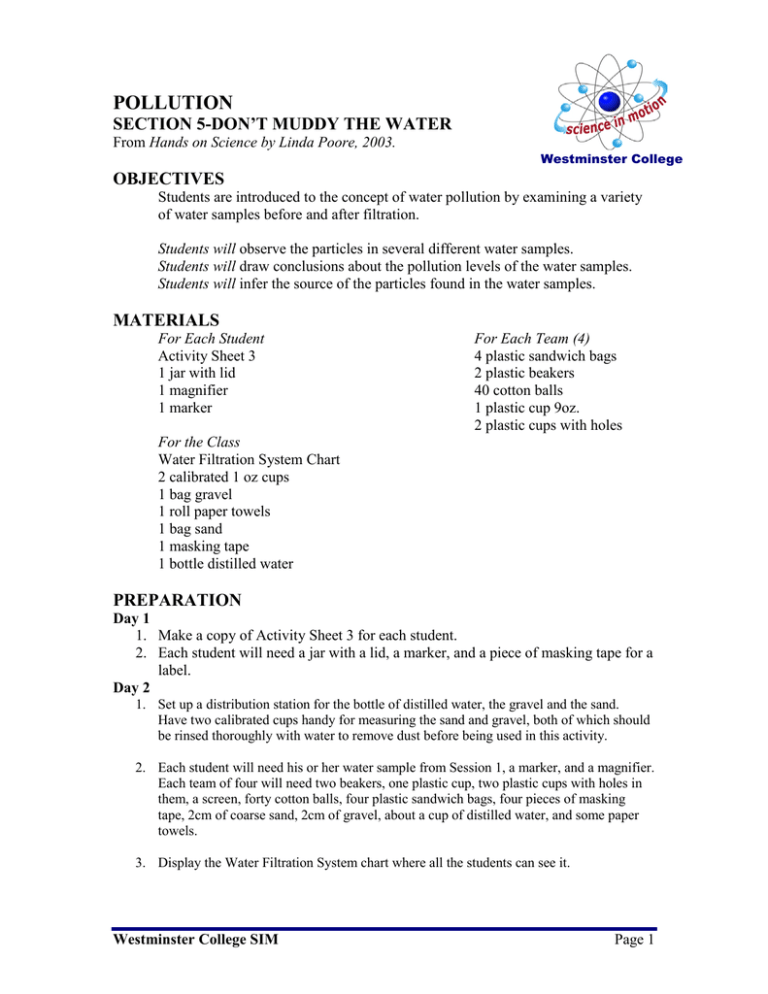
POLLUTION SECTION 5-DON’T MUDDY THE WATER From Hands on Science by Linda Poore, 2003. Westminster College OBJECTIVES Students are introduced to the concept of water pollution by examining a variety of water samples before and after filtration. Students will observe the particles in several different water samples. Students will draw conclusions about the pollution levels of the water samples. Students will infer the source of the particles found in the water samples. MATERIALS For Each Student Activity Sheet 3 1 jar with lid 1 magnifier 1 marker For Each Team (4) 4 plastic sandwich bags 2 plastic beakers 40 cotton balls 1 plastic cup 9oz. 2 plastic cups with holes For the Class Water Filtration System Chart 2 calibrated 1 oz cups 1 bag gravel 1 roll paper towels 1 bag sand 1 masking tape 1 bottle distilled water PREPARATION Day 1 1. Make a copy of Activity Sheet 3 for each student. 2. Each student will need a jar with a lid, a marker, and a piece of masking tape for a label. Day 2 1. Set up a distribution station for the bottle of distilled water, the gravel and the sand. Have two calibrated cups handy for measuring the sand and gravel, both of which should be rinsed thoroughly with water to remove dust before being used in this activity. 2. Each student will need his or her water sample from Session 1, a marker, and a magnifier. Each team of four will need two beakers, one plastic cup, two plastic cups with holes in them, a screen, forty cotton balls, four plastic sandwich bags, four pieces of masking tape, 2cm of coarse sand, 2cm of gravel, about a cup of distilled water, and some paper towels. 3. Display the Water Filtration System chart where all the students can see it. Westminster College SIM Page 1 DON’T MUDDY THE WATERS BACKGROUND INFORMATION The same pollutants found in the air can eventually fall to the ground and pollute our water. However, the biggest sources of freshwater pollution are sewage, industrial and agricultural waste, and mining. Polluted ponds and lakes are often unable to support fish and other aquatic life. Polluted rivers carry their waste to the ocean, which is itself subject to oil spills and dumping. Almost all water must be cleaned before it is fit to drink. Filtration – either naturally through the ground or through a specially designed water purification system- is a commonly use method of cleaning water. GUIDING THE ACTIVITY Day 1 1. Divide the class into teams of four. Give each student a collecting jar with a lid, a piece of masking tape, a marker, and a copy of Activity Sheet 3. Explain that each team will need to collect one water sample from four different sources (such as ponds, streams, puddles, rain, faucets, or drinking fountains). Encourage students to see out unusual water sources. Some students may be able to obtain samples from a factory or agricultural run-off area. Others may have access to a lake or stream. Still others may know of private wells. 2. When each team has decided where it will obtain its samples, have the members fill in the column on Activity Sheet 3 under the heading Location of Water Source. Tell the students to use a piece of masking tape and the marker to label their collecting jars with their name and Sample A, B, C, or D depending on which sample they have chosen to obtain. Have them write the location of the water source on the tape as well. Tell the students to bring their water samples to class for Day 2. Day 2 3. Divide the class into the same teams of four. Tell each tea to have its four jars of water samples handy. Then direct their attention to the chart of the water filtration system while you distribute the magnifiers, sandwich bags, pieces of tape, cotton balls, cups, beakers, screens, and paper towels to each team. Next, write the word filtration on the board and explain that filtration refers to the process of removing impurities from a liquid by passing it through a porous substance (such as a filter). Tell the students that they are going to make a water filtration system like the one in the chart and use it to test the purity of their four water samples. Westminster College SIM Page 2 DON’T MUDDY THE WATERS 4. To build a water filtration system, have each team take the two plastic cups with holes in them and place ten cotton balls in one cup and a screen in the other. Tell them to place the cup with the screen inside the cup with the cotton balls. 5. Have one member from each team bring the two cups, fitted together, up to the distribution station. Pour a layer of sand 2cm (about ¾ in.) thick into the cup with the screen. Pour a layer of coarse gravel 2 cm (about ¾ in.) thick on top of the sand. Have the students return to their seats and set the two cups on top of one of the beakers. The filtration system is now ready for water Sample A. Make sure sand and gravel have been rinsed thoroughly and are free of dust. Westminster College SIM Page 3 DON’T MUDDY THE WATERS 6. Direct each team to observe the appearance of the water in the jar they have labeled Sample A. Have the students use the Visible Pollution scale at the bottom of the activity sheet to help them describe the physical appearance of the sample. Have them enter this level on the activity sheet under the heading Visible Pollution Level. Additional descriptive details can be included under the column heading Appearance: Before Filtering. 7. Have the teams pour about 100 mL of Sample A into their other beaker. Any remaining sample water should be saved for Activity 8. Next, have them pour their measured sample through the filtration system. After the water has passed through the layers of sand, gravel, and cotton and collected in the beaker at the bottom, ask, How does the appearance of the water before filtering compare with its appearance after filtering? Unless the sample water is quite clean to begin with, the water should be noticeably clearer after filtration. Tell the students to add this information to the activity sheet under the heading Appearance: After filtering. 8. Have the students remove the cotton-ball filter from the filtration system and squeeze out the excess water. Tell them to store the used cotton balls in a plastic sandwich bag and to label the bag Sample A. After students have had ample opportunity to examine the beaker of filtered water and compare it with the jar of unfiltered water, tell them to empty the beaker into a sink or other receptacle. SAFETY: Caution the students not to drink this water. Microorganisms that can cause disease may still be present in the water, even after it has been filtered. 9. Before filtering the next sample, have the students rinse their filtration systems with a small amount of distilled water, dispose of this water, and then insert a new 10-cotton-ball filter. Repeat steps 6 through 8 with water Samples B, C, and D, rinsing the filtration system with distilled water and replacing the cotton filter between each sample. 10. After all four water samples have been filtered and the used cotton filters stored in sandwich bags, direction the students to remove the cotton balls from each bag and examine them using a magnifier. Have them describe the particles they see and record their observations on Activity Sheet 3 under the heading Description of Particles in Filter. 11. Ask, Which water sample contained the most particles? Students should name the water sample that produced the dirtiest cotton filter and/or the dirties water, even after filtering. Westminster College SIM Page 4 DON’T MUDDY THE WATERS Ask, What do you think was the source of the particles found in each water sample? Soot and ash from factories, dirt from yards, plant waste and dust from farms are all possible responses. Ask, What is the relationship between the location of the water source and the concentration of particles found in the water sample? Have the students write their answers on the activity sheet and then share them with the class. Students may respond that water samples taken from sources outdoors, such as streams and puddles, seemed dirtier than water samples taken from faucets and drinking fountains. Ask, Is the water that contains the most particles also the most harmful to organisms in the environment? Not necessarily. The particles in a water sample may not be harmful to all organisms in the environment. For example, particles of decaying plant matter may contaminate drinking water, but they serve as fertilizer for growing plants. Ask, Is water that has had particles filtered out of it now free of pollution? Not necessarily. Some particles of pollution are so small that they are not caught in the filtering process. Similarly, a water sample may be particle-free but still contain bacteria and other harmful microorganisms which pas right through a filter. Ask, Is filtration a good method of removing pollutants from drinking water? Can you think of another method of purifying water? By now, students should understand that filtration is an effect way to remove many of the particles and pollutants from drinking water, but it does not by itself ensure the safety of the water. If they have not already done so, suggest the chemicals like chlorine are usually added to kill germs and other microscopic organisms that can cause illness. Boiling the water also kills germs. Westminster College SIM Page 5
